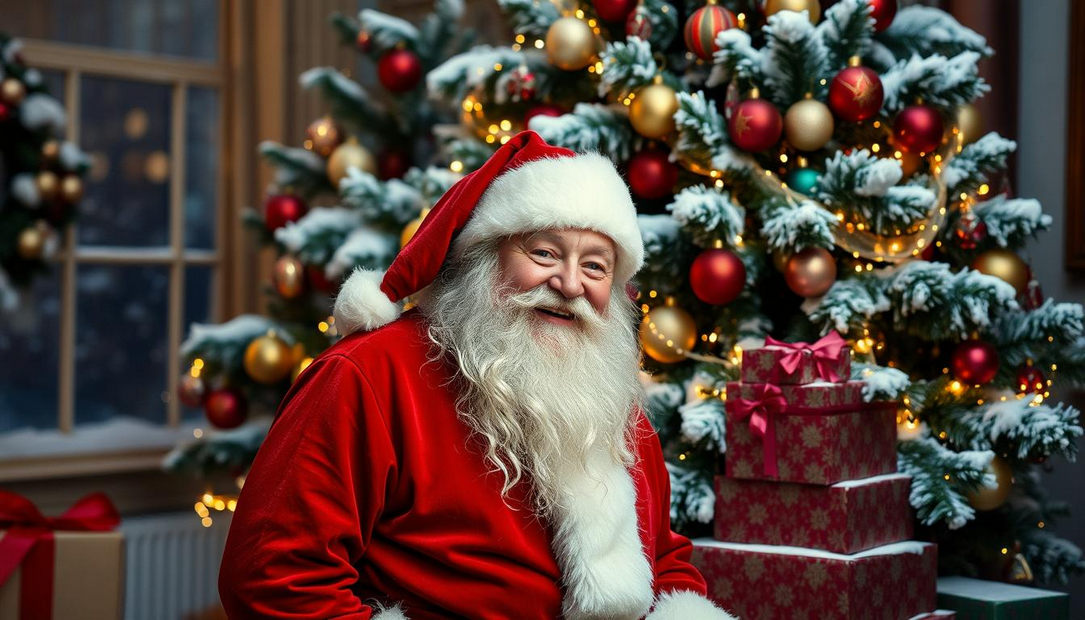The Secret Behind Santa’s Magic: How He Became a Christmas Icon
The story of Santa Claus is a beloved Christmas tradition. It has captured hearts around the world for many years. But have you ever thought about how this cheerful, gift-giving figure became so iconic? Let’s explore the history of Santa Claus and find out what makes him so special.
- The Ancient Origins of Saint Nicholas: From Holy Man to Holiday Hero
- The Real Saint Nicholas of Myra
- Early Acts of Generosity and Gift-Giving
- Religious Influence on Modern Santa
- The Secret Behind Santa’s Magic: How He Became a Christmas Icon
- The Evolution of Santa Claus Through Different Cultures
- European Influences on Santa’s Image
- American Transformation of Father Christmas
- Global Variations of the Santa Legend
- Santa’s Iconic Image: The Coca-Cola Connection
- Christmas Traditions That Shaped Santa’s Story
- The Legend of the North Pole Workshop
- Flying Reindeer and Magical Sleigh
- The Tradition of Christmas Eve Deliveries
- Santa’s Impact on Modern Holiday Culture
- The Psychology Behind Santa’s Universal Appeal
- Santa’s Influence on Global Christmas Celebrations
- Conclusion
- FAQ
- What is the history behind Santa Claus?
- How did Santa Claus become a Christmas icon?
- What are the cultural influences that have shaped Santa Claus?
- How did Coca-Cola’s advertising campaigns impact Santa’s image?
- What are some of the Christmas traditions that have shaped Santa’s story?
- How has Santa Claus impacted modern holiday culture?
- Why does Santa Claus have such universal appeal?
- How has Santa Claus influenced global Christmas celebrations?

Key Takeaways
- Explore the ancient origins of Saint Nicholas, the real-life holy man whose acts of generosity inspired the modern Santa Claus.
- Discover how religious beliefs and cultural traditions from around the world have shaped the image and legend of Santa Claus over time.
- Understand the role of the Coca-Cola company in popularizing Santa’s iconic red-and-white attire and solidifying his place in modern Christmas celebrations.
- Delve into the psychological reasons why Santa Claus holds such universal appeal, particularly for children.
- Examine the global impact of Santa Claus and how his influence has transcended cultural boundaries to become a symbol of holiday joy and wonder worldwide.
The Ancient Origins of Saint Nicholas: From Holy Man to Holiday Hero
The story of Santa Claus starts with Saint Nicholas of Myra in the 4th century. This Christian saint was known for his kindness and compassion. He became the inspiration for the Santa we know today, loved by people worldwide during the holidays.
The Real Saint Nicholas of Myra
Saint Nicholas was born in Myra, Turkey, in the 4th century AD. He was devoted to his faith and helped those in need. His kindness and secret gifts to the poor made him famous.
Early Acts of Generosity and Gift-Giving
- One famous story is about Saint Nicholas saving three young women from poverty by giving their father a dowry.
- Another legend tells of him bringing three boys back to life after a wicked innkeeper had murdered and pickled them.
These acts of generosity and gift-giving laid the groundwork for the Santa Claus legend. It spread across Europe and to the United States.
Religious Influence on Modern Santa
The legend of Saint Nicholas grew, influencing the modern Santa Claus. His connection to Christmas, gift-giving, and protecting children solidified his legacy. This made Saint Nicholas and the Santa Claus legend unforgettable.

The Secret Behind Santa’s Magic: How He Became a Christmas Icon
The story of Santa Claus is filled with centuries of tradition and symbolism. At its core, Santa represents the spirit of Christmas. This spirit is all about giving, joy, and the magic of the holiday season.
The santa claus magic we all love comes from Saint Nicholas, a saint from the fourth century. He was known for his kindness and love of giving. Over time, his story grew, and he became a symbol of christmas symbolism loved by many.
The change from Saint Nicholas to Santa Claus shows the lasting power of holiday traditions. Santa’s red suit, white beard, and North Pole workshop are all part of his magic. He brings joy and generosity to people everywhere, embodying the the spirit of christmas through santa.

The magic of Santa Claus brings joy to people of all ages. It’s the excitement of leaving out treats, the wait for presents, and the joy in a child’s eyes. Santa’s legacy reminds us of the importance of kindness, imagination, and the joy of the holiday season.
The Evolution of Santa Claus Through Different Cultures
The figure of Santa Claus has changed a lot over the years. He has been shaped by many cultures from all over the world. As he spread globally, his look and stories changed to fit each region’s customs.
European Influences on Santa’s Image
The story of Santa Claus starts with Saint Nicholas of Myra, a Christian bishop from the 4th century. He was known for his kindness. In Europe, figures like Sinterklaas in the Netherlands and Father Christmas in the UK influenced the modern Santa. They wore bishop robes and carried a staff, showing Saint Nicholas’s kindness.
American Transformation of Father Christmas
When Santa came to America, American culture changed him into the red-suited, jolly figure we know today. The North Pole, flying reindeer, and Christmas Eve deliveries were added in the US. These changes made Santa a beloved holiday symbol.
Global Variations of the Santa Legend
Though Santa’s story is known worldwide, each country has its own twist. In Germany, Christkind is a gift-giving angel. In Japan, Père Noël is joined by the playful Kōgatsu. These local versions of father christmas show how the legend can be adapted and loved everywhere.

The story of Santa Claus shows how this holiday figure can cross cultural lines. From his European beginnings to his American makeover and global variations, Santa’s journey continues to capture hearts worldwide.
Santa’s Iconic Image: The Coca-Cola Connection
The Coca-Cola company has greatly contributed to Santa Claus’s popularity. In the 1930s, they helped shape the image of Santa we know today. Their ads made Santa a symbol of Christmas.
Before Coca-Cola’s ads, Santa looked different in various cultures. But their illustrations made him the jolly, red-suited figure we see today. This image has become a key part of Christmas.
The Coca-Cola Santa is known for his kindness and joy. This fit perfectly with the brand’s values. This partnership made Santa a beloved figure around the world. It also boosted Coca-Cola’s sales and solidified the Santa Claus tradition.
| Year | Coca-Cola’s Santa Claus Advertising | Impact on Santa’s Image |
|---|---|---|
| 1931 | Coca-Cola commissioned illustrator Haddon Sundblom to create a series of advertisements featuring Santa Claus. | Sundblom’s depictions of Santa as a warm, friendly, and joyful figure became the standard for the modern Santa Claus image. |
| 1934 | Coca-Cola’s Christmas advertisements featured Santa delivering gifts and enjoying a refreshing Coca-Cola. | The association between Santa and Coca-Cola further cemented the brand’s role in shaping the santa claus tradition. |
| 1962 | Coca-Cola’s iconic “Pause that refreshes” campaign featured Santa Claus taking a break and enjoying a Coca-Cola. | This campaign reinforced the how santa became popular and the connection between Santa and the Coca-Cola brand. |
Coca-Cola’s marketing efforts have made Santa a beloved figure. Their partnership with Santa continues to shape our Christmas celebrations. It shows how important Santa is to the holiday season.

Christmas Traditions That Shaped Santa’s Story
The legend of Santa Claus is deeply connected to Christmas traditions. These traditions have grown over centuries. They include his North Pole workshop, flying reindeer, and the joy of gift-giving.
The Legend of the North Pole Workshop
The idea of Santa’s North Pole workshop is a cherished tradition. It comes from holiday folklore and myths from around the world. This place is where Santa and his elves make presents for children everywhere.
Flying Reindeer and Magical Sleigh
The image of Santa’s reindeer, led by Rudolph, is iconic. They pull his magical sleigh through the sky on Christmas Eve. This tradition fills children’s hearts with joy and wonder.
The Tradition of Christmas Eve Deliveries
Leaving treats for Santa on Christmas Eve is a global tradition. It’s a time for families to come together. It brings excitement and magic to the holiday.

These traditions, rooted in holiday folklore, have made Santa a beloved figure. They add to the magic of the holiday season.
Santa’s Impact on Modern Holiday Culture
Santa Claus has made a big mark on Christmas today. He is key in holiday marketing, charity, and family traditions. This has changed how people celebrate Christmas all over the world.
The santa claus impact on christmas shows in holiday sales. Stores use Santa to attract customers. They decorate windows and run ads with Santa to get people excited.
Santa also helps charities. Nonprofits use Santa to get donations and volunteers. This spreads christmas holiday spirit and kindness.
But Santa’s biggest impact is on families. Kids love writing to Santa and waiting for him on Christmas Eve. This magic makes Christmas special and brings families closer.
| Impact of Santa Claus on Christmas | Examples |
|---|---|
| Commercial Influence |
|
| Charitable Initiatives |
|
| Family Traditions |
|
In conclusion, santa claus impact on christmas and santa’s role in christmas have deeply shaped our holiday culture. Santa remains a beloved symbol of the season’s joy and giving.

The Psychology Behind Santa’s Universal Appeal
Santa Claus’s lasting popularity comes from his deep psychological impact on both kids and adults. The magic of Christmas stories and the legend of Santa have won hearts for generations. They’ve left a lasting mark on holiday traditions and our collective psyche.
Why Children Believe in Santa Claus
For kids, Santa’s magic is a world of wonder and imagination. Believing in Santa taps into their natural magical thinking. This is key to their childhood development.
This ability to believe in magic lets kids dive fully into Christmas stories. It brings excitement and anticipation to the holiday season.
The Role of Magic in Holiday Traditions
The Santa Claus legend is crucial to the holiday’s magic and wonder. The idea of Santa bringing gifts on Christmas Eve sparks the imagination. It adds to the festive mood.
This whimsy and enchantment create lasting memories. It strengthens the emotional bond to Santa’s magic, lasting into adulthood.
| Reasons Why Children Believe in Santa Claus | The Importance of Magic in Holiday Traditions |
|---|---|
|
|

“The santa claus magic is not just a story, it’s a timeless tradition that taps into the very essence of what makes the holiday season so special.”
Santa’s Influence on Global Christmas Celebrations
Santa Claus has become a beloved figure around the world. His jolly nature and magical gift-giving have shaped Christmas celebrations everywhere. This has made him a symbol of joy and togetherness.
In Europe’s snowy landscapes and the Southern Hemisphere’s sunny spots, Santa is a symbol of holiday cheer. His journey has adapted to local customs, bringing people together during the festive season.
| Region | Santa Claus Adaptation | Unique Traditions |
|---|---|---|
| Europe | Father Christmas, Père Noël, Weihnachtsmann |
|
| Latin America | Papá Noel, Viejito Pascuero |
|
| Asia | Dun Che Lao Ren, Jultomten |
|
The santa claus worldwide celebration brings people together, despite cultural differences. Santa’s journey around the world shows the power of cultural exchange. It highlights the spirit of the Christmas season.

Conclusion
The story of Santa Claus is a fascinating journey from Saint Nicholas to the iconic figure we love today. It’s a tale of holiday magic and cultural growth. We’ve seen how his legend grew from diverse traditions, marketing, and our desire for joy and wonder at Christmas.
Santa Claus is a symbol of the holiday spirit, showing us generosity, compassion, and the magic of Christmas. His lasting appeal shows the timeless values he stands for. He brings families and communities together to celebrate the joy of the season.
Looking ahead to Christmas 2024, Santa Claus will remain a key figure in our celebrations. He spreads kindness, hope, and the true meaning of the holiday. The story of Santa Claus is a remarkable journey across centuries and borders, making him a global icon of Christmas.
Santa’s role in bringing joy to both children and adults shows the power of storytelling. It fulfills our need for magic and wonder, especially at Christmas. As we end this year’s festivities, we look forward to Santa’s arrival and the celebration of his legacy in the future.
FAQ
What is the history behind Santa Claus?
Santa Claus started with Saint Nicholas of Myra, a 4th-century Christian saint. He was known for his kindness and generosity. Over time, his legend grew, influenced by many cultures. Today, we know Santa as the jolly figure we love.
How did Santa Claus become a Christmas icon?
Santa became a Christmas icon through his kind spirit and the magic he brings. Marketers and advertisers also helped make him famous. His role in spreading joy and gifts has made him a beloved figure.
What are the cultural influences that have shaped Santa Claus?
Santa’s image has been shaped by many cultures. The Dutch Sinterklaas, British Father Christmas, and American Santa are just a few examples. These influences have made Santa a global legend.
How did Coca-Cola’s advertising campaigns impact Santa’s image?
Coca-Cola’s ads in the 1930s made Santa look like we know him today. They showed him in a red-and-white suit. These images helped make Santa a part of American culture and boosted his popularity.
What are some of the Christmas traditions that have shaped Santa’s story?
Christmas traditions like the North Pole workshop and flying reindeer have shaped Santa’s story. The tradition of delivering gifts on Christmas Eve also plays a big role. These stories have made Santa a beloved figure.
How has Santa Claus impacted modern holiday culture?
Santa is a key part of today’s Christmas celebrations. He influences holiday marketing, charity, and family traditions. His presence makes the holiday season special for people all over the world.
Why does Santa Claus have such universal appeal?
Santa’s appeal comes from the magic and joy of gift-giving. These feelings are shared by both children and adults. Santa represents the heart of Christmas and the holiday magic.
How has Santa Claus influenced global Christmas celebrations?
Santa has become a symbol of holiday cheer worldwide. Different cultures have added their own twist to the Santa legend. His influence can be seen in how communities celebrate Christmas around the globe.








